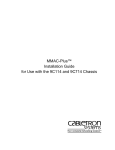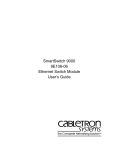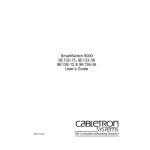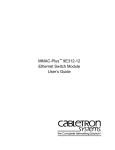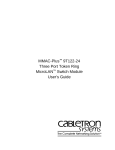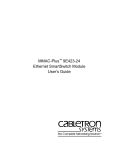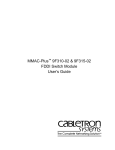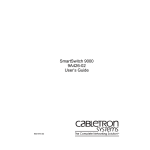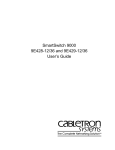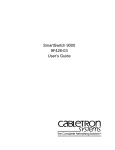Download Cabletron Systems 9C300-1 User`s guide
Transcript
MMAC-Plus™ 9C300-1 Environmental Module User’s Guide Notice Notice Cabletron Systems reserves the right to make changes in specifications and other information contained in this document without prior notice. The reader should in all cases consult Cabletron Systems to determine whether any such changes have been made. The hardware, firmware, or software described in this manual is subject to change without notice. IN NO EVENT SHALL CABLETRON SYSTEMS BE LIABLE FOR ANY INCIDENTAL, INDIRECT, SPECIAL, OR CONSEQUENTIAL DAMAGES WHATSOEVER (INCLUDING BUT NOT LIMITED TO LOST PROFITS) ARISING OUT OF OR RELATED TO THIS MANUAL OR THE INFORMATION CONTAINED IN IT, EVEN IF CABLETRON SYSTEMS HAS BEEN ADVISED OF, KNOWN, OR SHOULD HAVE KNOWN, THE POSSIBILITY OF SUCH DAMAGES. © Copyright November 1994 by: Cabletron Systems, Inc. 35 Industrial Way Rochester, NH 03867-0505 All Rights Reserved Printed in the United States of America Order Number: 9031155 November 1994 LANVIEW is a registered trademark and MMAC-Plus is a trademark of Cabletron Systems, Inc. VT100 is a registered trademark of Digital Equipment Corporation. Ethernet is a trademark of Xerox Corporation. CompuServe is a registered trademark of CompuServe, Incorporated. i Notice FCC Notice This device complies with Part 15 of the FCC rules. Operation is subject to the following two conditions: (1) this device may not cause harmful interference, and (2) this device must accept any interference received, including interference that may cause undesired operation. NOTE: This equipment has been tested and found to comply with the limits for a Class A digital device, pursuant to Part 15 of the FCC rules. These limits are designed to provide reasonable protection against harmful interference when the equipment is operated in a commercial environment. This equipment uses, generates, and can radiate radio frequency energy and if not installed in accordance with the operator’s manual, may cause harmful interference to radio communications. Operation of this equipment in a residential area is likely to cause interference in which case the user will be required to correct the interference at his own expense. WARNING: Changes or modifications made to this device which are not expressly approved by the party responsible for compliance could void the user’s authority to operate the equipment. DOC Notice This digital apparatus does not exceed the Class A limits for radio noise emissions from digital apparatus set out in the Radio Interference Regulations of the Canadian Department of Communications. Le présent appareil numérique n’émet pas de bruits radioélectriques dépassant les limites applicables aux appareils numériques de la class A prescrites dans le Règlement sur le brouillage radioélectrique édicté par le ministère des Communications du Canada. ii Contents Chapter 1 Introduction Using This Manual........................................................................................................ 1-1 The 9C300-1 Environmental Module ......................................................................... 1-1 Features ................................................................................................................... 1-2 Related Manuals............................................................................................................ 1-3 Getting Help .................................................................................................................. 1-4 Chapter 2 Installing the 9C300-1 Environmental Module Installing the 9C300-1 Environmental Module......................................................... 2-1 Chapter 3 9C300-1 Environmental Module Operation Monitoring Functions................................................................................................... 3-1 External Ambient Temperature............................................................................ 3-2 Fan Speed ................................................................................................................ 3-3 System Humidity ................................................................................................... 3-4 System Voltages...................................................................................................... 3-4 Internal Operating Temperature.......................................................................... 3-4 LANVIEW LEDs .................................................................................................... 3-5 Out-of-Band Management ........................................................................................... 3-6 COM1 and COM2 Ports........................................................................................ 3-7 The Ethernet™ Port Interface Module (EPIM) .................................................. 3-8 LCD and Keypad ................................................................................................... 3-8 Non-Interactive Mode .................................................................................................. 3-9 Non-Interactive Mode Screens............................................................................. 3-9 The System Screen .......................................................................................... 3-9 The Utilization Screen .................................................................................. 3-10 The Environment Screen.............................................................................. 3-10 The Power Screen ......................................................................................... 3-11 The System Banner Screen........................................................................... 3-11 Interactive Mode ......................................................................................................... 3-12 Interactive Mode Screens.................................................................................... 3-12 The Main Screen............................................................................................ 3-13 The Alarm Screen.......................................................................................... 3-13 The System Screen ........................................................................................ 3-14 The Power Screen ......................................................................................... 3-15 The Power Supply Specific Screen ............................................................. 3-15 The Environment Screen.............................................................................. 3-16 The Communications Screen ...................................................................... 3-16 iii Contents The Diagnostic Module Selection Screen .................................................. 3-17 The Diagnostic Results Screen .................................................................... 3-17 The BBU Screen ............................................................................................. 3-18 The Module Selection Screen ...................................................................... 3-18 The Module Specific Screen......................................................................... 3-19 The Module Environment Screen............................................................... 3-20 The Module Memory Screen ....................................................................... 3-20 The Module Backplane Screen .................................................................... 3-21 The Environmental Module Specific Screen ............................................. 3-21 The Environmental Module Environment Screen ................................... 3-22 The LCD Contrast Adjustment Screen....................................................... 3-23 Chapter 4 Specifications Safety............................................................................................................................... 4-1 Service ............................................................................................................................. 4-1 Physical ........................................................................................................................... 4-2 Environmental ............................................................................................................... 4-2 Appendix A EPIM Specifications Introduction ..................................................................................................................A-1 EPIM-T ...........................................................................................................................A-1 EPIM-F1 and EPIM-F2.................................................................................................A-2 EPIM-F3 .........................................................................................................................A-4 EPIM-C...........................................................................................................................A-6 Connector Type .....................................................................................................A-6 Grounding..............................................................................................................A-6 EPIM-A and EPIM-X (AUI Port) ................................................................................A-7 Appendix B Uninterruptible Power Supply (UPS) Introduction ...................................................................................................................B-1 Connecting a UPS to an EM.........................................................................................B-1 Configuring COM Port for UPS ..................................................................................B-2 Verifying Configuration ...............................................................................................B-3 Monitoring UPS.............................................................................................................B-3 iv Chapter 1 Introduction Using This Manual Read through this manual to become familiar with its contents and to gain an understanding of the features and capabilities of the Environmental Module prior to installing and operating it. Chapter 1 Introduction, provides product descriptions and features, gives a brief description of the 9C300-1 Environmental Module and ends with a list of related manuals. Chapter 2 Installing the 9C300-1 Environmental Module, contains detailed information for unpacking and installing the Environmental Module. Chapter 3 9C300-1 Environmental Module Operation, contains detailed information about the Environmental Module operation. Chapter 4 Specifications, provides detailed specifications for the 9C300-1 Environmental Module. Appendix A EPIM Specifications, contains detailed information about the various that can be used with the 9C300-1 Environmental Module. Appendix B Uninterruptible Power Supply (UPS), contains detailed information about connecting, configuring, and monitoring a UPS. The 9C300-1 Environmental Module The 9C300-1 Environmental Module, shown in Figure 1-1, provides system cooling, out-of band management capabilities, and environmental/power monitoring for the MMAC-Plus System. The Environmental Module is inserted in the slot above the module card cage in the front of the MMAC-Plus chassis. 1-1 Introduction MMAC EPIM STATUS ALARM 9C300-1 1 2 3 4 5 6 ENTER COM 1 COM 2 7 8 9 10 11 12 13 14 Figure 1-1. The 9C300-1 Environmental Module Features System Cooling The 9C300-1 Environmental Module houses the cooling fan subsystem. There are four, high-air flow fans in the assembly to provide necessary chassis cooling. Any one of these can fail without adversely affecting system operation. The fans’ operation and speed are continuously monitored, allowing network technicians to be quickly notified if repairs are needed. Control of the fans’ operating speed is also provided for maximum cooling efficiency and fan life. The fans are protected from controller failure by a fail-safe circuit. In the event of a controller malfunction, this circuit forces the fan subsystem to maximum speed and notifies Network Management. Out-of-Band Management Out-of-band management refers to managing the MMAC-Plus via a Local Management (LM) connection or an SNMP-based management application which does not use the same network connection to the chassis as “user data.” Four Out-of-band management interfaces are built into the 9C300-1 Environmental Module. One channel is the 4x40 character backlit LCD and associated five button keypad. This interface provides a network manager or technician with the capability to review system status, performance and configuration information. Two interfaces are serial RS-232 ports. These ports support local management via a VT100 session, SLIP, or PPP, or monitor an American Power Conversion Smart UPS. The remaining out-of-band management interface supports any standard Cabletron Ethernet Port Interface Module (EPIM). This interface provides a direct connection to the internal System Management Bus-10 (SMB-10). 1-2 Related Manuals Environmental/Power Monitoring The 9C300-1 Environmental Module monitors and reports chassis power parameters, ambient chassis temperature, chassis humidity, temperature of the Environmental Module itself, as well as the status and speed of the chassis cooling fans. Flash EEPROM The capability of downloading future firmware upgrades has been built into the 9C300-1 Environmental Module. Hot Swapping The 9C300-1 Environmental Module can be removed from the chassis while the MMAC-Plus is running without interrupting network performance. LANVIEW® LEDs Two LEDs, STATUS and ALARM, are built into the front of the 9C300-1 Environmental Module. These LEDs indicate the status of the Environmental Module and the presence or absence of system alarms. Related Manuals The manuals listed below should be used to supplement the procedures and technical data contained in this manual. MMAC-Plus Installation Guide MMAC-Plus Operations Guide MMAC-Plus 9C214-AC Power Supply User’s Guide In addition, each Interface Module has a user’s guide. 1-3 Introduction Getting Help If you need additional support related to the Environmental Module, or if you have any questions, comments or suggestions concerning this manual, feel free to contact Cabletron Systems Technical Support: By phone: (603) 332-9400 By CompuServe®: GO CTRON from any ! prompt 1-4 By Internet mail: [email protected] By Fax: (603) 337-3075 By BBS: (603) 335-3358 By mail: Cabletron Systems, Inc. P.O. Box 5005 Rochester, NH 03866-5005 Chapter 2 Installing the 9C300-1 Environmental Module Installing the 9C300-1 Environmental Module The 9C300-1 Environmental Module is installed in the slot above the module card cage in the front of the MMAC-Plus chassis, as shown in Figure 2-1. Install an Environmental Module by following the steps below: 1. Unpack the Environmental Module by removing it from the shipping box and sliding the two foam end caps off the unit. (Save the shipping box and packing materials in the event the Environmental Module must be reshipped.) 2. Remove it from the protective plastic bag. Observe all precautions to prevent damage from Electrostatic Discharge (ESD). (Save the bag in the event the Environmental Module must be reshipped.) 3. Remove the plastic protective cap that covers the connector on the rear of the Environmental Module. 4. Examine it carefully, checking for damage. If any damage exists, DO NOT install it. Immediately contact Cabletron Systems Technical Support. 5. Hold the left and right sides. 6. Line up the rails on the left and right sides with the tracks on the left and right inside panels of the chassis. 7. Slide the Environmental Module into the chassis until it is completely seated. If the MMAC-Plus chassis has been powered up, the 9C300-1 Environmental Module illuminates the STATUS and ALARM LEDs and displays the name Cabletron on the LCD. If the LEDs are any color other than green, refer to LANVIEW LEDs in Chapter 3. If no keypad entries are made within 60 seconds, the LCD scrolls through various non-interactive mode screens. 2-1 Installing the 9C300-1 Environmental Module If the MMAC-Plus chassis has not been powered up, make sure that all modules have been properly installed; then power up the MMAC-Plus chassis by following the steps in the MMAC-Plus Installation Guide. MMAC EPIM STATUS ALARM 9C3001 1 2 3 4 5 6 7 8 COM 1 9 10 ENTER COM 2 11 12 13 14 Figure 2-1. Installing the Environmental Module 2-2 Chapter 3 9C300-1 Environmental Module Operation The 9C300-1 Environmental Module, as shown in Figure 3-1, performs three main functions. It monitors several chassis environmental parameters, provides multiple out-of-band management interfaces, as well as system cooling. The Environmental Module also includes LANVIEW® LEDs for at-a-glance diagnostics. MMAC EPIM STATUS ALARM 9C300-1 1 2 3 4 5 6 7 ENT ER COM 1 COM 2 8 9 10 11 12 13 14 Figure 3-1. The 9C300-1 Environmental Module Monitoring Functions The 9C300-1 Environmental Module monitors the following MMAC-Plus functions: • • • • • External ambient temperature Fan speed System humidity System voltages Internal operating temperature 3-1 9C300-1 Environmental Module Operation External Ambient Temperature The 9C300-1 Environmental Module includes an external ambient temperature sensor. This sensor is located on the front of the Environmental Module, as shown in Figure 3-2. The ambient temperature is monitored and the results of the monitoring are available to the network manager via the LCD, as well as local and remote management. MMAC EPIM STATUS ALARM 9C300-1 1 2 3 4 5 6 ENTER COM 1 COM 2 7 8 9 10 11 12 13 14 External ambient temperature sensor Figure 3-2. External Ambient Temperature Sensor Table 3-1 lists the ambient temperature information available to the network manager. Table 3-1. External Ambient Temperature Temperature Range 3-2 LCD Display 6°C/43°F and below COLD 7–12°C/44–54°F COOL 13–32°C/55–90°F NORM (normal) 33–38°C/91–101°F WARM 39°C/102°F and above HOT Monitoring Functions Fan Speed The 9C300-1 Environmental Module adjusts the speed of the system cooling fans (Figure 3-3) based on the external ambient temperature. Fan speed increases as ambient temperature rises to ensure adequate cooling for the system. Conversely, fan speed decreases as ambient temperature decreases. In the event the ambient temperature sensor, or the Environmental Module itself, fails, fan speed defaults to maximum speed to ensure adequate cooling. The ability to control fan speed is useful for two reasons: • • To increase the cooling level of the MMAC-Plus system to accommodate changing operating environments. To prolong fan life and limit audible noise when full fan speed is not necessary for cooling. Fan Tray Side View Front panel Fan Tray Top View System Cooling Fans Figure 3-3. The 9C300-1 Environmental Module and Fan Tray 3-3 9C300-1 Environmental Module Operation System Humidity The 9C300-1 Environmental Module monitors the non-condensing humidity level of the MMAC-Plus. The results of the monitoring are available to the network manager via LCD, as well as local and remote management. The humidity levels are displayed as shown in Table 3-2. Table 3-2. System Humidity Humidity LCD Display 0–45% STATIC RISK 46–94% NORM (normal) 95% and above MOIST System Voltages The 9C300-1 Environmental Module monitors specific system power parameters to ensure that they are within acceptable limits. The power parameters monitored from the backplane are the 48 volt DC System Power Bus and the INB Termination Power Bus. The power parameter monitored within the Environmental Module is the 12 volt internal line. The results of the monitoring are available to the network manager via LCD, as well as local and remote management. Voltages above or below the acceptable voltage limits cause an alarm to be sent to the network manager. Table 3-3 summarizes these acceptable voltage limits. Table 3-3. Acceptable Voltage Limits Description Acceptable Voltage Limits 48 volt DC System Power Bus From 40 volts to 59 volts INB Termination Power Bus From 3.1 volts to 5 volts 12 volt internal line From 11 volts to 13 volts Internal Operating Temperature The 9C300-1 Environmental Module monitors its own internal operating temperature by comparing its current temperature to the ambient temperature and programmed rise temperatures to determine current temperature status. If the temperature of the Environmental Module exceeds normal operating limits, an alarm is sent to the network manager. In addition, if the ambient temperature sensor fails, pre-established temperature ranges have been programmed to ensure proper internal temperature monitoring. 3-4 Monitoring Functions LANVIEW LEDs The LANVIEW LEDs on the front of the 9C300-1 Environmental Module may be used as an aid in troubleshooting. There are two LEDs visible to the user (Figure 3-4): the STATUS LED and the ALARM LED. STATUS LED MMAC EPIM STATUS ALARM 9C300-1 1 2 3 4 5 6 COM 1 COM 2 7 8 9 10 ENT ER 11 12 13 14 ALARM LED Figure 3-4. 9C300-1 Environmental Module LANVIEW LEDs The STATUS LED indicates the current status of the Environmental Module processor and peripherals. The possible states and descriptions of the STATUS LED are listed in Table 3-4. Table 3-4. STATUS LED LED Color State Description Green Functional Fully operational. Yellow/Green Booting Flashes green and yellow while booting. Yellow Testing Testing system. Yellow (Flashing) Crippled Not fully operational. Red Reset Normal power-up reset. Red (Flashing) Failed Fatal error has occurred. Off Power off Lack of 5 volt input to the Environmental Module. 3-5 9C300-1 Environmental Module Operation The ALARM LED indicates the presence, or absence, of an unread system alarm(s). Unread system alarms can be read using the LCD and five-function keypad. The possible states and descriptions of the ALARM LED are listed in Table 3-5. Table 3-5. ALARM LED LED Color State Description Green Functional No unread alarms. Yellow Functional Pending unread system alarms, warning. Red Functional Pending unread system alarms, critical. Out-of-Band Management Out-of-band management refers to managing the system via a Local Management (LM) connection or an SNMP-based management application which does not use the same network connection to the chassis as “user data.” The 9C300-1 Environmental Module provides four out-of-band management interfaces for managing the MMAC-Plus system. These interfaces are listed below: • • • 3-6 Two serial communication ports, COM1 and COM2 One standard Cabletron EPIM interface Liquid Crystal Display (4 lines by 40 characters) and an associated five button keypad Out-of-Band Management COM1 and COM2 Ports The 9C300-1 Environmental Module front panel has two RJ-45 communication ports for RS-232 serial communication to and from the MMAC-Plus. Figure 3-5 illustrates a single RJ-45 communication port connector. COM1 and COM2 can be configured to run the Serial Line Internet Protocol (SLIP), Point-to-Point Protocol (PPP), Local Management via a terminal or modem connection, or monitor an American Power Conversion Smart UPS. Refer to the Local Management Manual for detailed information on configuring the COM1 or COM2 port. Pin 1 Figure 3-5. RJ-45 Communication Port Connector Table 3-1 details the pinout connections for an RJ-45 communication port connector. Table 3-6. Pinout Connections RJ-45 Communication Port Connector Pin Description 1 TRANSMIT 2 DATA CARRIER DETECT 3 DATASET READY 4 RECEIVE 5 SIGNAL GROUND 6 DATA TERMINAL READY 7 REQUEST TO SEND 8 CLEAR TO SEND 3-7 9C300-1 Environmental Module Operation The Ethernet™ Port Interface Module (EPIM) The 9C300-1 Environmental Module provides a port for Cabletron Systems EPIMs. The EPIM provides a direct connection to the internal SMB-10 bus. This connection can be used for out-of-band graphical SNMP management of the MMAC-Plus system or a Telnet session into local management. Any standard Cabletron EPIM can be installed. Refer to Appendix A for detailed information on the EPIM. LCD and Keypad The LCD functions as a “window” into the MMAC-Plus System, allowing users to navigate through various screens via the five-function keypad. The LCD is a 4 line by 40 character, backlit liquid crystal visual display. The five-function keypad is used to scroll through MMAC-Plus information screens, and to select option fields within each menu and submenu. The keypad consists of five buttons, four of which are directional to move the cursor; the fifth is the Enter button, used to make menu selections. Figure 3-6 shows the LCD with a System Banner Screen and the five-function keypad on the MMAC-Plus Environmental Module front panel. CABLETRON SYSTEMS, INC. MMAC-PLUS <ALARMS> <SYSTEM> <MODULES> <SCREEN CONTRAST> ENTER Figure 3-6. The LCD and Five-Function Keypad 3-8 Non-Interactive Mode Non-Interactive Mode The LCD defaults to this mode if there is no user input within 60 seconds of installation of the Environmental Module or system start-up. Non-Interactive Mode Screens This section describes the LCD screens that display in the non-interactive mode. The LCD scrolls through different status screens (depending on MMAC-Plus configuration), displaying each screen for a period of 7 seconds; or, until user input is sensed on the keypad. Line 4 of each screen displays any active alarm conditions that exist within the system. If no alarm conditions exist, the line displays “SYSTEM STATUS NORMAL.” If an alarm condition exists, line 4 displays a message describing the alarm for 5 seconds. The screen then displays a message stating how many alarms are present in the alarm queue, “XX ALARMS PENDING” and the ALARM LED on the front of the Environmental Module turns yellow or red indicating unread alarms in the queue. The System Screen The System Screen, as shown in Figure 3-7, is the first screen of the non-interactive mode. Lines 1 and 2 display the MMAC-Plus chassis Internet Protocol (IP) address and Media Access Control (MAC) address. Line 3 displays the current chassis hardware revision and serial number. Line 4 displays the system status. CHASSIS IP ADDRESS xxx.xxx.xxx.xxx CHASSIS MAC ADDRESS xx-xx-xx-xx-xx-xx CHASSIS HW REV xxx SN xxxxxxxxxxxx SYSTEM STATUS NORMAL Figure 3-7. The System Screen 3-9 9C300-1 Environmental Module Operation The Utilization Screen The Utilization Screen, as shown in Figure 3-8, is the second screen of the non-interactive mode. Line 1 displays the screen heading. Line 2 displays the FDDI 1 and FDDI 2 bus utilization. Line 3 displays the INB A and INB B bus utilization. Line 4 displays the system status. SYSTEM UTILIZATION FDDI 1_ _ _ _ _ 100% FDDI 2 _ _ _ _ _100% INB A _ _ _ _ _100% INB B _ _ _ _ _ 100% SYSTEM STATUS NORMAL Figure 3-8. The Utilization Screen The Environment Screen The Environment Screen, as shown in Figure 3-9, is the third screen of the non-interactive mode. Line 1 displays the screen heading. Line 2 displays the external temperature of the chassis in both Fahrenheit and Celsius and qualifies the temperature as COLD, COOL, NORM (normal), WARM or HOT based on system parameters. Line 3 displays the non-condensing humidity level of the chassis and qualifies it as STATIC RISK, NORM (normal) or MOIST based on system parameters. Line 4 displays the system status. CHASSIS ENVIRONMENT EXTERNAL TEMP xxx˚F xx˚C NORM HUMIDITY xxx% NORM SYSTEM STATUS NORMAL Figure 3-9. The Environment Screen 3-10 Non-Interactive Mode The Power Screen The Power Screen, as shown in Figure 3-10, is the fourth screen of the non-interactive mode. Line 1 displays the screen heading. Line 2 displays the percentage of power being used. Line 3 displays the availability of power redundancy. Line 4 displays the system status. CHASSIS POWER POWER LOAD_ _ _ _ _ _ _ _ _ _ 100% POWER REDUNDANCY AVAILABLE SYSTEM STATUS NORMAL Figure 3-10. The Power Screen The System Banner Screen The System Banner Screen, as shown in Figure 3-11, is the fifth screen of the non-interactive mode. The information that displays is the default information built into the system. Lines 1 and 2 display the Cabletron name and the system name. Line 3 displays the system uptime. Line 4 displays the system status. CABLETRON SYSTEMS INC. MMAC-PLUS SYSTEM UPTIME hh:mm:ss SYSTEM STATUS NORMAL Figure 3-11. The System Banner Screen 3-11 9C300-1 Environmental Module Operation Interactive Mode The LCD enters this mode upon installation. This mode allows user input through the five-function keypad to navigate through MMAC-Plus status screens, and to make menu selections. Press any button on the keypad to enter this mode from the non-interactive mode. Once past the Main screen, the Interactive Mode is maintained for three minutes without a keypad entry before returning to the non-interactive mode. Interactive Mode Screens This section describes the LCD screens that display in the Interactive Mode. The Interactive Mode screen flow, as shown in Figure 3-12, provides a representation of the Interactive Mode screen structure hierarchy. Main Screen System Pwr Pwr Supply Specific Environment Alarms Modules Diag Com BBU Modules Selection Screen Screen Adjust Results Modules/Environmental Module Specific Screen Environment Memory Figure 3-12. Interactive Mode Screen Flow 3-12 Screen Contrast Backplane Interactive Mode The Main Screen The Main Screen, as shown in Figure 3-13, is the initial screen of the Interactive Mode. It allows access to all of the Interactive Mode screens. Interactive Mode screens are distinguished by the display of option fields. Option fields are designated with brackets (< >). To select an option, highlight the option field by using the arrow function keys to place the cursor on the option; then press the ENTER key. Lines 1 and 2 display the screen heading. Line 3 displays the <ALARMS> option field. Access information about any current alarms by selecting this item. Line 4 displays the <SYSTEM>, <MODULES> and <SCREEN CONTRAST> options. Select the appropriate option to access information on the desired category. CABLETRON SYSTEMS INC MMAC-PLUS <ALARMS> <SYSTEM> <MODULES> <SCREEN CONTRAST> Figure 3-13. The Main Screen The Alarm Screen Select the <ALARMS> option field in line 3 of the Main Screen, as shown in Figure 3-13, to access the alarm message queue. Unread alarms are present in the message queue when the ALARM LED is red. Line 1 of the Alarm Screen, as shown in Figure 3-14, displays the current alarm in the queue as well as the date and time the alarm occurred. Lines 2 and 3 show the description of the current alarm including the module and parameter(s) causing the alarm. If other alarms are in the queue (indicated by x > 1 on line 1), select <MORE> to see the information screens for them. ALARM y of x 11/05/94, 11:23 Alarm Description Field Alarm Description Field <MORE> <ACKNOWLEDGE> <EXIT> Figure 3-14. The Alarm Screen 3-13 9C300-1 Environmental Module Operation Select <ACKNOWLEDGE> after reading all alarms to reset the front panel ALARM LED (red to green). Selecting <ACKNOWLEDGE> deletes all alarms and resets the alarm pending banner on line 4 of the non-interactive screens. Select <EXIT> to return to the Main Screen. The System Screen Select the <SYSTEM> option field in line 4 of the Main Screen, as shown in Figure 3-13, to access the System Screen as shown in Figure 3-15. This screen displays information specific to the MMAC-Plus chassis. Lines 1 and 2 display the MMAC-Plus chassis Internet Protocol (IP) address and Media Access Control (MAC) address. Line 3 displays the current chassis hardware revision and serial number. Line 4 lists the following five submenus. Access a specific submenu by selecting it on the screen. <PWR> Displays general power supply configuration information, with the option to view statistics on specific power supply modules. <ENV> Displays environmental information about the chassis. <COM> Displays statistics and information about the front panel COM ports and EPIM on the Environmental Module. <DIAGS> Displays the results of power-up or restart diagnostic tests. <BBU> Displays status of BBUs, if they are installed. CHASSIS IP ADDRESS xxx.xxx.xxx.xxx CHASSIS MAC ADDRESS xx-xx-xx-xx-xx-xx CHASSIS HW REV xxx SN xxxxxxxxxxxx <PWR> <ENV> <COM> <DIAGS> <BBU> <EXIT> Figure 3-15. The System Screen Select <EXIT> to return to the Main Screen. 3-14 Interactive Mode The Power Screen Select <PWR> from the System Screen, as shown in Figure 3-15, to access information about the chassis power supply configuration. Line 1 of the Power Screen, as shown in Figure 3-16, displays the number of power supplies currently configured and the availability of power redundancy. Lines 2 and 3 display the power supply status as either ON, OFF DUE TO MANAGEMENT, or FAULT. Line 4 is used to access information about a specific power supply module by selecting a power supply number. SUPPLIES INSTALLED 2 PWR REDUNDANCY STATUS 1 ON 2 ON <1> <2> <EXIT> Figure 3-16. The Power Screen Select <EXIT> to return to the System Screen. The Power Supply Specific Screen Select a power supply number from line 4 of the Power Screen, as shown in Figure 3-16, to learn about a specific power supply in the MMAC-Plus chassis. There is an LCD screen available for each installed power supply, as shown in Figure 3-17. Line 1 identifies the power supply selected and its serial number. Line 2 identifies the power supply’s hardware revision, firmware revision of the diagnostic controller and power loading factor as a percentage of its capacity. Line 3 provides the input and output voltages of the power supply. PWR SUPPLY 1 SN xxxxxxxxxxxx HW REV xxx FW REV x.xx.xx LOAD xxx% PWR IN 110V PWR OUT 57.1V 5.1V 3.3V <EXIT> Figure 3-17. The Power Supply Specific Screen Select <EXIT> to return to the Power Screen. 3-15 9C300-1 Environmental Module Operation The Environment Screen Select <ENV> from the System Screen, as shown in Figure 3-15, to view environmental parameters of the MMAC-Plus. Line 1 of this screen, as shown in Figure 3-18, displays the external temperature of the current chassis in both Fahrenheit and Celsius, and qualifies the temperature as COLD, COOL, NORM (normal), WARM, or HOT, based on system parameters. Line 2 displays the current system non-condensing humidity level, qualified as STATIC RISK, NORM (normal), or MOIST, based on system parameters. Line 3 displays the current fan speed of the Environmental Module cooling system as a percentage of maximum rotational velocity. CHASSIS EXTERNAL TEMP xxx°F xx°C NORM CHASSIS HUMIDITY xxx% NORM FAN SPEED 1 xxx% 2 xxx% 3 xxx% 4 xxx% <EXIT> Figure 3-18. The Environment Screen Select <EXIT> to return to the System Screen. The Communications Screen Select <COM> from the System Screen, as shown in Figure 3-15, to access MMAC-Plus chassis communication port status information. Line 1, as shown in Figure 3-19, displays the status of the Ethernet Port Interface Module (EPIM) as either ENABLED, DISABLED or N/A if not installed. Line 2 displays the Port Administration status of COM port 1 (enabled or disabled), the application in use (such as Local Management (LM), SLIP, PPP or UPS), the baud rate of the attached device (a VT100 type terminal or modem) and the port operational status (active or inactive). Line 3 displays the Port Administration status of COM port 2 in the same manner as described for line 2. COMMUNICATIONS PORTS EPIM ENABLED COM 1 ENABLED SLIP 9600 ACTIVE COM 2 ENABLED <EXIT> Figure 3-19. The Communications Screen Select <EXIT> to return to the System Screen. 3-16 Interactive Mode The Diagnostic Module Selection Screen Select <DIAGS> from the System Screen, as shown in Figure 3-15, to view the Diagnostic Module Selection screen. Line 1, as shown in Figure 3-20, displays the screen heading. Lines 2 and 3 show the chassis slot locations in which modules have been installed in the MMAC-Plus. Line 4 displays Power Supply Units and BBUs configured in the MMAC-Plus. Diagnostic test results for these units can be viewed individually. The Diagnostic Results Screen displays the diagnostic test results for the selected modules. It provides an itemized list of failed tests only. VIEW DIAG RESULTS ON <EM> <1> <2> <3> <4> <5> <6> <7> <8><9> <10> <11> <12> <13> <14> <PS1> <PS2> <BBU1> <EXIT> Figure 3-20. The Diagnostic Module Selection Screen Select <EXIT> to return to the System Screen. The Diagnostic Results Screen The Diagnostic Results Screen, as shown in Figure 3-21, displays the results of failed tests for the modules selected on the Diagnostic Screen. Line 1 displays the module(s) selected for diagnostics. Lines 2 and 3 display failed test results; or, if no failures occurred, the message ALL DIAGNOSTICS TESTS HAVE PASSED. MODULE xx Test Results (Left Blank if all pass) or ALL MODULE DIAGNOSTICS TESTS HAVE PASSED <MORE> <EXIT> Figure 3-21. The Diagnostic Results Screen Select <MORE> to view more failed tests for the current module. Select <EXIT> to return to the Diagnostic Module Selection Screen. 3-17 9C300-1 Environmental Module Operation The BBU Screen Select <BBU> from the System Screen, as shown in Figure 3-15, to view the status of the Battery Backup Units (BBUs). Figure 3-22 shows the BBU Screen. Line 1 displays the screen heading. Line 2 displays BBU status (CHARGING, STANDBY or DISCHARGING) if BBUs are installed; however, if no BBUs are installed, the message NO BBU INSTALLED displays. Line 3 displays the estimated amount of system run time stored in the BBUs if the system is running on a standard power source; or, if the system is running on BBUs, the amount of system run time remaining in the BBUs at the current power load. BATTERY STATUS BBU CHARGING SYSTEM RUN TIME AT PWR LOSS xxx MINUTES <EXIT> Figure 3-22. The BBU Screen Select <EXIT> to return to the System Screen. The Module Selection Screen Select <MODULES> from the Main Screen, as shown in Figure 3-13, to display the chassis slot locations in which modules have been installed. Line 1, as shown in Figure 3-23, displays the screen heading. Lines 2 and 3 list all modules in the MMAC-Plus by slot number. MODULE SELECTION <EM> <1> <2> <3> <4> <5> <6> <7> <8> <9> <10> <11> <12> <13> <14> <EXIT> Figure 3-23. The Module Selection Screen Select <EXIT> to return to the main System Screen. 3-18 Interactive Mode The Module Specific Screen Select a module on the Module Selection Screen, as shown in Figure 3-23, to display configuration information on the Module Specific Screen, as shown in Figure 3-24. Line 1 identifies the selected module by chassis slot location, current status, and hardware revision. A module’s status can be one of the following: ON-LINE The host processor is operational. DOWN The host processor is not operational. FAULT The power-up diagnostic tests have failed. Lines 2 and 3 display a firmware revision and SMB-1 firmware revision, along with the BOOT PROM revision and the module serial number. Line 4 lists the following three submenus. Access a specific submenu by selecting it on the screen. <ENV> accesses the Module Environment Screen, showing environmental parameters for the selected module. <MEMORY> accesses the Module Memory Screen, showing the amount of various memory categories on the module. <BACKPLANE> accesses the Module Backplane Screen, showing backplane configuration parameters. MODULE xx STATUS ON-LINE HW REV xxx FW REV x.xx.xx SMB 1 FW REV x.xx.xx BOOT PROM REV x.xx.xx SN xxxxxxxxxxxx <ENV> <MEMORY> <BACKPLANE> <EXIT> Figure 3-24. The Module Specific Screen Select <EXIT> to return to the Module Selection Screen. 3-19 9C300-1 Environmental Module Operation The Module Environment Screen Select <ENV> at the Module Specific Screen, as shown in Figure 3-24, to display environmental parameters for the specific module. Line 1 of the Module Environment Screen, as shown in Figure 3-25, identifies the selected module by chassis slot location. Line 2 displays the measured input voltage from the 48 volt system power bus to the module’s DC-to-DC converter. The MMAC-Plus power supply provides voltage to the module via a chassis backplane. The converter’s 5 volt output line is also shown on line 2. Line 3 displays the module’s current temperature in Fahrenheit and Celsius. The temperature is qualified as either COLD, COOL, NORM (normal), WARM, or HOT based on system parameters. MODULE xx INPUT PWR: xx.xV, OUTPUT PWR x.xV TEMP: xxx°F, xx°C NORM <EXIT> Figure 3-25. The Module Environment Screen Select <EXIT> to return to the Module Specific Screen. The Module Memory Screen Select <MEMORY> at the Module Specific Screen, as shown in Figure 3-24, to view the memory configuration of a selected module. Line 1 of the Module Memory Screen, as shown in Figure 3-26, identifies the module, and its current CPU loading factor, expressed as a percent of capacity. Line 2 displays the amount of FLASH memory (in megabytes) installed on the module. Line 3 displays the amount of SHARED DRAM and LOCAL DRAM (in megabytes) installed on the module. MODULE xx, CPU LOAD xxx% FLASH xx MB SHARED DRAM xx MB LOCAL DRAM xx MB <EXIT> Figure 3-26. The Module Memory Screen Select <EXIT> to return to the Module Specific Screen. 3-20 Interactive Mode The Module Backplane Screen Select <BACKPLANE> on the Module Specific Screen, as shown in Figure 3-24, to access the Module Backplane Screen, as shown in Figure 3-27. The Module Backplane Screen displays the current MMAC-Plus backplane configuration for a selected module. Line 1 identifies the selected module by chassis slot location. Line 2 displays the module’s FNB connection (if applicable) and connection status. Refer to the MMAC-Plus Operation Guide for further information about FNB configuration. Line 3 displays the module’s INB connection (if applicable) and connection status. Refer to the MMAC-Plus Operation Guide for further information about the INB. MODULE xx FDDI 1 INS PRI FDDI 2 BYP INB A B/W ALLOC xxx MBPS <EXIT> Figure 3-27. The Module Backplane Screen Select <EXIT> to return to the Module Specific Screen. The Environmental Module Specific Screen Select <EM> on the Module Selection Screen, as shown in Figure 3-23, to access the Environmental Module Specific Screen, as shown in Figure 3-28. Line 1 displays the Environmental Module’s current status (on-line or fault) and the hardware revision. Line 2 displays the Environmental Module’s firmware and boot prom revision. Line 3 displays the Environmental Module serial number. EM STATUS ON-LINE HW REV xxx FW REV x.xx.xx BOOT PROM REV x.xx.xx SN xxxxxxxxxxxx <ENV> <EXIT> Figure 3-28. The Environmental Module Specific Screen Select <ENV> to access the Environmental Module Environment Screen (used to view Environmental Module electrical and environmental parameters). Select <EXIT> to return the display to the Module Selection Screen. 3-21 9C300-1 Environmental Module Operation The Environmental Module Environment Screen Select <ENV> on the Environmental Module Specific Screen, as shown in Figure 3-28, to access the Environmental Module Environment Screen, as shown in Figure 3-29. This screen displays voltage, temperature, and non-condensing humidity readings for the Environmental Module. Line 1 displays the measured values for the 48 volt DC power bus and the 3.3 volt bus for the Internal Network Bus (INB) terminator modules. The MMAC-Plus power supply system provides these voltages as input to the Environmental Module. The acceptable limits for the 48 volt line are between 40 and 59 volts. The acceptable limits for the 3.3 volt line are between 3.1 and 5 volts. Line 2 displays the temperature of the Environmental Module in Fahrenheit and Celsius. The temperature is qualified as either COLD, COOL, NORM (normal), WARM, or HOT based on system parameters. Line 3 displays the Environmental Module’s non-condensing humidity level as STATIC RISK, NORM (normal) or MOIST, based on system parameters. INPUT PWR 56.1V 3.3V TEMP: xxx°F, xx°C NORM HUMIDITY: xx% NORM <EXIT> Figure 3-29. The Environmental Module Environment Screen Select <EXIT> to return to the Environmental Module Specific Screen. 3-22 Interactive Mode The LCD Contrast Adjustment Screen Select <SCREEN CONTRAST> from the Main Screen, as shown in Figure 3-13, to access the LCD Contrast Adjustment Screen, as shown in Figure 3-30. Select <LIGHTER> and press ENTER (repeat as necessary) to make the displayed characters appear lighter on the screen. Select <DARKER> and press ENTER (repeat as necessary) to make the displayed characters appear darker on the screen. SCREEN CONTRAST ADJUSTMENT <LIGHTER> ___________ <DARKER> <EXIT> Figure 3-30. LCD Contrast Adjustment Screen Select <EXIT> to return to the Main Screen. NOTE The LCD contrast setting reverts to the darkest setting at power-up or restart of the Environmental Module. 3-23 9C300-1 Environmental Module Operation 3-24 Chapter 4 Specifications Safety ! CAUTION It is the responsibility of the person who sells the system to which the modules will be a part to ensure that the total system meets allowed limits of conducted and radiated emissions. The 9C300-1 Environmental Module, when properly installed in the MMAC-Plus chassis, complies with the following safety specifications and standards. • • • • • • • • UL 1950 CSA C22.2 No. 950 EN 60950 IEC 950 EMI requirements of FCC Part 15 Class A EN 55022 Class A VCCI Class I EMC requirements of EN 50082-1 IEC 801-2 ESD IEC 801-3 Radiated Susceptibility IEC 8-1-4 EFT Service The 9C300-1 Environmental Module is designed with the following service capability: MTBF (MIL-STD-217): >200,000 hours projected MTTR: <.50 hour 4-1 Specifications Physical Dimensions 12.7 H x 43.2 W x 44.5 D centimeters (5 H x 17 W x 17.5 D inches) Weight Unit: Shipping: 6.5 kilograms (14 pounds) 7.7 kilograms (17 pounds) Environmental Operating Temperature: 5–40°C, 43–100°F Operating Humidity: 5% to 95% non-condensing Cooling: 21.8 cubic meters of air per minute drawn through the chassis 770 cubic feet of air per minute drawn through the chassis 4-2 Appendix A EPIM Specifications Introduction The 9C300-1 Environmental Module provides a port for Cabletron Systems EPIMs. EPIMs let you connect to the main network using different media types. Cabletron Systems offers a variety of EPIMs whose specifications are explained in the following sections. EPIM-T The EPIM-T is an RJ-45 connector supporting UTP cabling. It has an internal Cabletron Systems TPT-T™ 10BASE-T Twisted Pair Transceiver. The slide switch on the EPIM-T determines the crossover status of the cable pairs. If the switch is on the X side, the pairs are internally crossed over. If the switch is on the = side, the pairs are not internally crossed over. Figure A-1 shows the pinouts for the EPIM-T in both crossover positions. Position X (crossed over) 1. RX+ 2. RX3. TX+ 4. NC 5. NC 6. TX7. NC 8. NC Position = (not crossed over) 1. TX+ 2. TX3. RX+ 4. NC 5. NC 6. RX7. NC 8. NC Figure A-1. EPIM-T Pinouts A-1 EPIM Specifications EPIM-F1 and EPIM-F2 The EPIM-F1 and EPIM-F2 support Multimode Fiber Optic cabling. Each EPIM has an internal Cabletron Systems FOT-F™ Fiber Optic Transceiver. The EPIM-F1 is equipped with SMA Connectors and the EPIM-F2 is equipped with ST Connectors. Figure A-2 shows both EPIMs. Specifications for the EPIMs are listed in Table A-1. Figure A-2. EPIM-F1 and EPIM-F2 Table A-1. EPIM-F1 & EPIM-F2 Specifications Parameter Typical Value Worst Case Typical Budget Receive Sensitivity -30.5 dBm -28.0 dBm — — Peak Input Power -7.6 dBm -8.2 dBm — — Transmitter power parameters are listed Table A-2. A-2 Worst Case Budget EPIM-F1 and EPIM-F2 Table A-2. Transmitter Power Parameter NOTE Typical Value Worst Case Worst Case Budget Typical Budget 50/125 µm fiber -13.0 dBm -15.0 dBm 13.0 dB 17.5 dB 62.5/125 µm fiber -10.0 dBm -12.0 dBm 16.0 dB 20.5 dB 100/140 µm fiber -7.0 dBm -9.0 dBm 19.0 dB 23.5 dB Error Rate Better than 10-10 The transmitter power levels and receive sensitivity levels listed are Peak Power Levels after optical overshoot. A Peak Power Meter must be used to correctly compare the values given above to those measured on any particular port. If Power Levels are being measured with an Average Power Meter, then 3 dBm must be added to the measurement to correctly compare those measured values to the values listed (i.e., -30.5 dBm peak = -33.5 dBm average). A-3 EPIM Specifications EPIM-F3 The EPIM-F3 supports Single Mode Fiber Optic cabling. It has an internal Cabletron Systems FOT-F™ Fiber Optic Transceiver and is equipped with ST Connectors. Figure A-3 shows the EPIM-F3. Specifications for the EPIM-F3 are listed in Figure A-4 and Table A-3. Figure A-3. EPIM-F3 Maximum Sensitivity (-36.0) Receive Sensitivity Typical Sensitivity (-31.0) Minimum Sensitivity (-30.0) Minimum Receive Input (-9.72) Typical Receive Input (-7.5) Maximum Receive Input Power Maximum Receive Input (-6.99) Maximum Transmit Power (-12.0) Transmitter Power* (At 25°C into 8.3/125µm fiber) Typical Transmit Power (-15.5) Minimum Transmit Power (-21.0) dBm -40 -35 -30 -25 -20 -15 -10 Less Power * Transmit Power Coefficient (See Note Below) -5 0 More Power Typical Power Minimum Power Maximum Power -0.15dBm/°C -0.12 dBm/°C -0.18 dBm/°C Figure A-4. EPIM-F3 Power and Sensitivity Specifications NOTE A-4 Transmitter Power decreases as temperatures rise and increases as temperatures fall. Use the Output Power Coefficient to calculate increased or decreased power output for your operating environment. For example, the typical power output at 25°C is -16.4 dBm. For a 4°C temperature increase, multiply the typical coefficient (-0.15 dBm) by four and add the result to typical output power (4 x -0.15 dBm + -16.4 = -17.0). EPIM-F3 Table A-3. EPIM-F3 Specifications Parameter NOTE Typical Minimum 1270 nm Maximum Transmitter Peak Wave Length 1300 nm Spectral Width 60 nm Rise Time 3.0 nsec 2.7 nsec 5.0 nsec Fall Time 2.5 nsec 2.2 nsec 5.0 nsec Duty Cycle 50.1% 49.6% 50.7% Bit Error Rate Better than 10-10 - 1330 nm 100 nm The transmitter power levels given above are Peak Power Levels after optical overshoot. You must use a Peak Power Meter to correctly compare the values given above to those measured on any particular port. If you are measuring power levels with an Average Power Meter, add 3 dBm to the average power measurement to correctly compare the average power values measured to the values listed above (i.e., -33.5 dBm average + 3 dB = -30.5 dBm peak). A-5 EPIM Specifications EPIM-C The EPIM-C supports thin-net coaxial cabling and is equipped with an internal Cabletron Systems TMS-3™ Transceiver. You can use the TERM switch on the front of the EPIM-C to set the internal 50-ohm terminator. This eliminates the need to connect the port to a tee-connector and terminator. Figure A-5 shows the setting for the terminator switch. Internal Termination Switch = On (internally terminated) = Off (need external termination) Figure A-5. EPIM-C Connector Type This connector type is a BNC receptacle, with gold center contact, for use with BNC type tee-connectors and RG-58 thin-net cable. Grounding For safety reasons, only one end of a thin-net segment should be connected to earth ground. Connection to earth ground at more than one point on the segment may cause dangerous ground currents. The BNC port of the Coaxial Interface Modules is not connected to earth ground. A-6 EPIM-A and EPIM-X (AUI Port) EPIM-A and EPIM-X (AUI Port) The EPIM-A is a DB-15 female connector used to attach segments to an external transceiver. The EPIM-X is equipped with dual internal transceivers. It has a DB-15 male connector used to attach segments to an AUI cable. Figure A-6 shows both modules. Figure A-6. The EPIM-A and EPIM-X Table A-4 lists the DB-15 pinouts. Table A-4. DB-15 Pinouts Pin Number Represents Pin Number Represents 1 Logic Ref. 10 Transmit - 2 Collision + 11 Logic Ref. 3 Transmit 12 Receive - 4 Logic Ref. 13 Power (+12Vdc) 5 Receive 14 Logic Ref. 6 Power Return 15 No Connection 7 No Connection 9 Collision - *Connector Shell: *Connector Shell Positive Ground Protective Ground A-7 EPIM Specifications A-8 Appendix B Uninterruptible Power Supply (UPS) Introduction The MMAC-Plus can be connected to a UPS to provide an uninterruptible source of AC power. Two UPS models are available, the Matrix 3000 and the Matrix 5000. Either can be monitored via remote SNMP Management after connecting the UPS to the Environmental Module (EM). Connecting a UPS to an EM To connect a UPS to an EM, use the RJ-45/DB-9 adapter labeled “UPS”, the RJ-45 cable included in the 9372089 kit shipped with the EM, and follow the steps below. 1. Plug the RJ-45/DB-9 adapter labeled “UPS” into the receptacle on the rear of the UPS (Figure B-1). 2. Plug one end of the cable with the RJ-45 connector into the RJ-45/DB-9 adapter labeled “UPS” on the rear of the UPS (Figure B-1). 3. Plug the other end of the cable with the RJ-45 connector into the COM2 port on the front of the EM inserted in the MMAC-Plus Chassis (Figure B-1). B-1 Uninterruptible Power Supply (UPS) 9 Pin D Connector Receptacle MMAC EPIM STATUS COM 1 COM 2 ALARM ENTER 9C3001 1 2 3 4 5 6 7 8 9 10 11 12 13 14 Matrix UPS (Back View) COM Ports MMAC-Plus Chassis (Front View) Figure B-1. Connecting EM to UPS Configuring COM Port for UPS After the UPS has been connected to the COM2 port, the COM2 port must be configured for UPS Management. To configure the COM2 port for UPS Management, follow the steps below. 1. Connect the terminal or PC used for local management to the COM1 port on the Environmental Module (EM) and press RETURN until the Slot Selection Screen displays. 2. At the Slot Selection Screen, enter 0 (zero) to display the EM Configuration Screen. 3. At the EM Configuration Screen, cursor to the Application Field for the COM2 port. 4. Using the space bar, toggle to the UPS option. 5. Using the tab key, tab to the SAVE option and press RETURN. If you need additional information about configuring the COM ports, refer to the Local Management User’s Guide. B-2 Verifying Configuration Verifying Configuration After configuring the COM port for a UPS, verify the configuration was done correctly by checking the Communications Screen on the EM. Follow the steps below to verify the configuration. 1. At the Main Screen select <SYSTEM> and press ENTER. 2. At the System Screen select <COM> and press ENTER. 3. At the Communications Screen, verify that the screen displays “ENABLED UPS 2400 ACTIVE FOR COM PORT 2”. Monitoring UPS Information about the operation of the UPS is obtained via Remote SNMP Management or locally by the LCD on the front of the UPS. Refer to the UPS User’s Guide, provided by the vendor, for detailed information on the UPS LCD. B-3 Uninterruptible Power Supply (UPS) B-4


















































